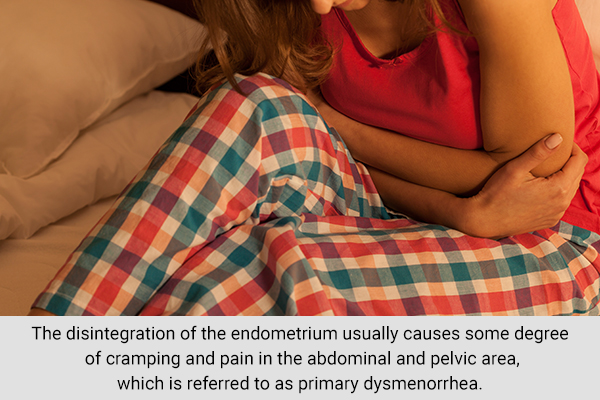In this article:
Your menstrual cycle can give you insights into your inner health. If your periods are normal in terms of frequency, duration, and volume of flow, then your reproductive system is working fine. Plus, regular menstruation between puberty and menopause is taken as a sign of overall well-being. (1)

Conversely, menstrual abnormalities can point to underlying health issues that warrant medical attention. In most cases, early diagnosis can make these problems easier to manage and can reduce the risk of serious complications that may occur if it is left untreated.
So, it is important to monitor your period and look out for certain irregularities or symptoms that can indicate some hidden ailment.
Menstrual Abnormalities and Associated Health Problems
Here’s your guide to understanding what your period problem can be a sign of.
1. Irregular periods are a sign of PCOS and diabetes
The menstrual cycle begins on the first day of the period and lasts for 28 days on average, but its duration can range from 21 to 35 days. This means that you should ideally get a period after every 21 to 35 days, with each period lasting for 2–7 days.
However, the following menstrual irregularities could indicate polycystic ovary syndrome (PCOS):
- If you get your period too early or too late on a regular basis
- If your menstrual flow is abnormally heavy or light
- If you keep missing periods or have not had a period in 3 consecutive months
PCOS or polycystic ovarian disease (PCOD) is a common hormonal disorder that affects females of reproductive age (between 12 and 51 years). It is characterized by oversized ovaries covered with small cysts that secrete excessive amounts of male hormones (androgens).
The spike in androgens keeps the ovaries from regularly releasing eggs (ovulation), which makes you skip your periods. Besides erratic menstruation, the irregular ovulation also makes it difficult to get pregnant.
High androgen levels in females also trigger abnormal hair growth on the body and face such as that in men. It can also increase the risk of heart disease and diabetes in the long term.
Currently, there is no cure for PCOD, but it can be effectively managed through medication, diet, and lifestyle modifications. (2)
2. Extreme cramping and lower abdominal pain during periods could be a sign of endometriosis

The endometrium is a layer of epithelial tissue along with mucous membranes that forms the inner lining of the uterus. The ovaries release an egg during each menstrual cycle to be fertilized by a sperm and induce a pregnancy. This ovulation process causes the endometrium to thicken and prepare the uterus for housing a potential embryo.
However, when the egg remains unfertilized and pregnancy doesn’t occur, the thickened uterine lining breaks down and gets eliminated from the body in the form of menstrual flow. This shedding process is triggered by the release of certain hormonal compounds including a prostaglandin called PGF2a, which makes the uterus shrink.
The disintegration of the endometrium usually causes some degree of cramping and pain in the abdominal and pelvic area, which is referred to as primary dysmenorrhea. This is normal period pain or dysmenorrhea that is experienced by women with normal pelvic anatomy.
However, there is another kind of period pain called secondary dysmenorrhea, which is triggered by underlying pelvic problems and is far more severe. The most common culprit behind this problem is endometriosis, (3) wherein endometrial tissue grows outside the uterus but acts in the same way as the inner uterine lining.
When this misplaced tissue sheds, it does not have a passage to bleed out like normal endometrium. So, the blood collects in the surrounding area, causing swelling, inflammation, debilitating belly/pelvic pain, scar tissue, gastrointestinal problems, pain during sex, and heavy menstrual flow.
Endometriosis is a chronic condition that affects more than 10% of women and is the leading cause of infertility among them. There aren’t many treatments for this condition, (4) but you must consult your doctor to manage it the best you can.
You can use pain meds to deal with mild symptoms, but you will need proper medical help for chronic pain that persists for months. (5)
3. Heavy bleeding may indicate fibroids/endometrial cancer/iron deficiency anemia
Menorrhagia refers to prolonged or excessive menstrual bleeding, which affects a lot of women. It is characterized by periods that last for more than a week, are abnormally heavy, or both.
This gynecological problem can occur due to a variety of reasons, with fibroids being a leading cause. (6) Fibroids, also known as leiomyomas, are the most prevalent form of noncancerous tumor found in women during the reproductive years.
A recent study reported women with fibroids were far more likely to experience heavy menstrual bleeding than those without. (6)
Menorrhagia can also be a sign of endometrial cancer or endometriosis. (7)
Moreover, the significant blood loss due to this problem can give rise to iron deficiency anemia. Some warning signs can alert you to the possibility of this, such as feeling extremely lethargic despite no physical effort, pale skin, running out of breath, and heart palpitations. If you experience any of these symptoms, get yourself checked out for anemia and seek proper treatment.
A 2019 study found that heavy menstrual bleeding can negatively impact one’s ferritin levels and overall physical function to a great degree as the duration of the menstrual period becomes longer. (8)
The fact that this problem accounts for nearly 30% of all hysterectomies performed in the USA points to how serious it can be. (9)
4. A lighter flow during a period or the absence of a period may indicate excessive stress, a heart problem, or a bone problem

Hypomenorrhea is a condition wherein your menstrual period is shorter or lighter than usual. The menstrual flow may last less than 2 days, may be very scant, or both.
Meanwhile, amenorrhea is defined as the complete absence of menstrual bleeding. While it is normal for menstruation to cease after menopause, many women also experience occasional amenorrhea at the peak of their childbearing age.
If skipping periods becomes a frequent occurrence among young women, it can be due to a serious underlying issue and have long-term health consequences. (10)
Light menstrual bleeding or missed periods can be the result of high stress levels. (11)
The lack of menstruation also indicates that your ovaries are not functioning properly and not making enough estrogen. Estrogen is a female hormone that is essential for various physiological functions, especially for preserving your cardiovascular and bone health.
Low estrogen levels put you at an increased risk of heart disease, stroke, and loss of bone mass leading to osteoporosis. (12)
Most-Asked Questions
Is it normal for postmenopausal women to experience uterine bleeding?
No, even the slightest uterine bleeding after menopause points to an underlying issue that can be potentially dangerous. So, you must seek immediate medical evaluation to avoid undue complications.
What is meant by abnormal menstrual or uterine bleeding?
The following conditions fall under the category of abnormal menstrual bleeding:
- Heavy volume of menstrual flow
- Periods that last for more than 7 days
- Absence of menstruation
- Bleeding between regular periods
- Spotting
These kinds of menstrual irregularities are often caused by hormonal fluctuations associated with endometriosis and PCOS. However, certain other factors can also trigger them, including:
- Birth control interventions such as copper T intrauterine device (IUD) and oral contraceptives
- Uterine or cervical infection
- Uterine fibroids
- Blood clotting disorder
- Cancer, particularly uterine, cervical, and vaginal cancers
- Long-term medical conditions such as renal ailments, thyroid problems, diabetes, and liver disease
Final Word
Keep track of your monthly menstrual period, and consult your doctor if you notice any abnormalities to rule out serious underlying issues and seek treatment if needed. This kind of monitoring will also help the doctor diagnose the problem more easily.
However, bear in mind that it is completely normal to experience some irregularities now and then. The minutest of fluctuation should not throw you off and does not warrant medical assistance.
However, if the problem becomes a frequent occurrence or starts interfering with your daily life, then take it as your body’s way of telling you that something is wrong and requires attention. It’s best to heed the call and treat the problem before it escalates into something more serious.
Many a time, you will find that it is a false alarm, but still, it is better to be safe than sorry.
- Was this article helpful?
- YES, THANKS!NOT REALLY


